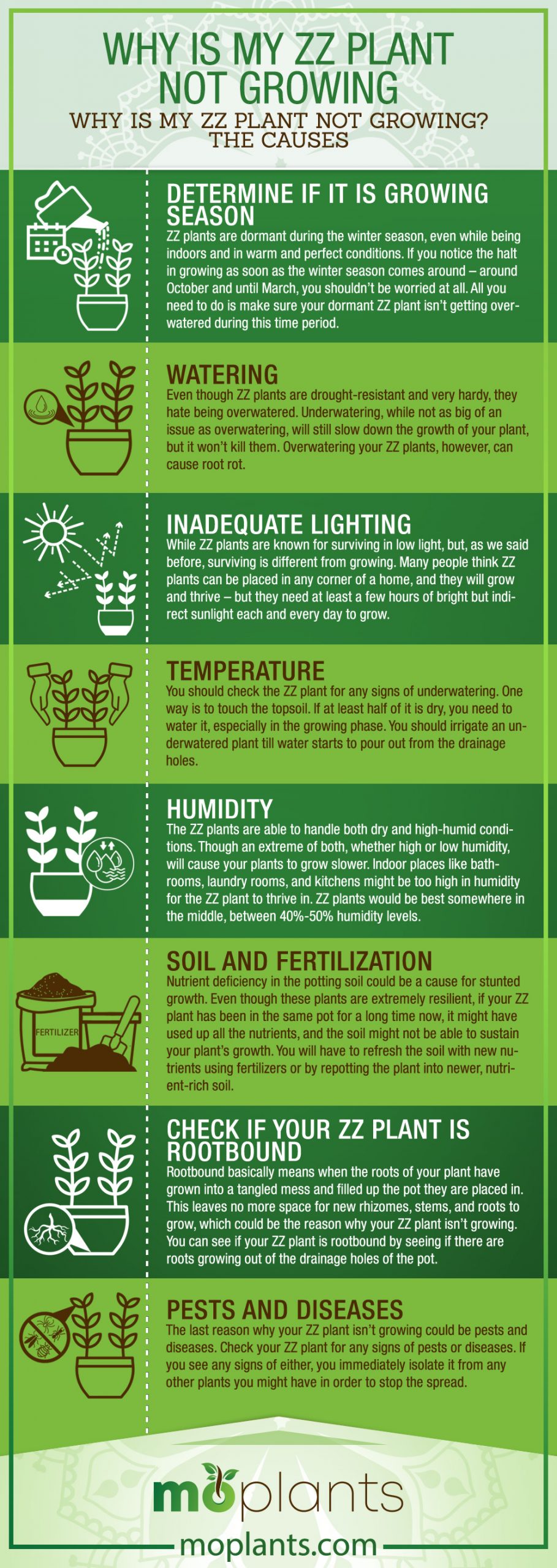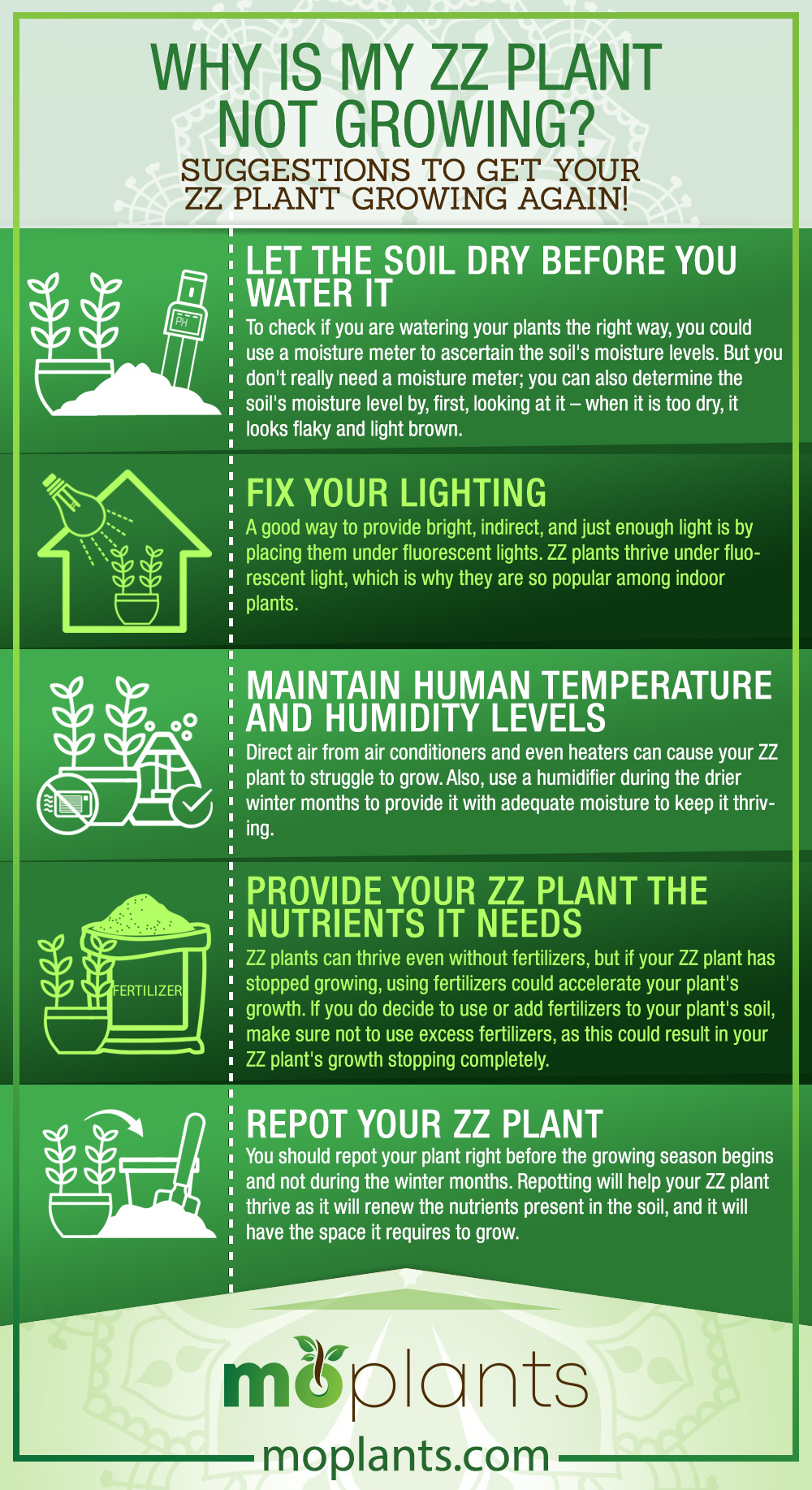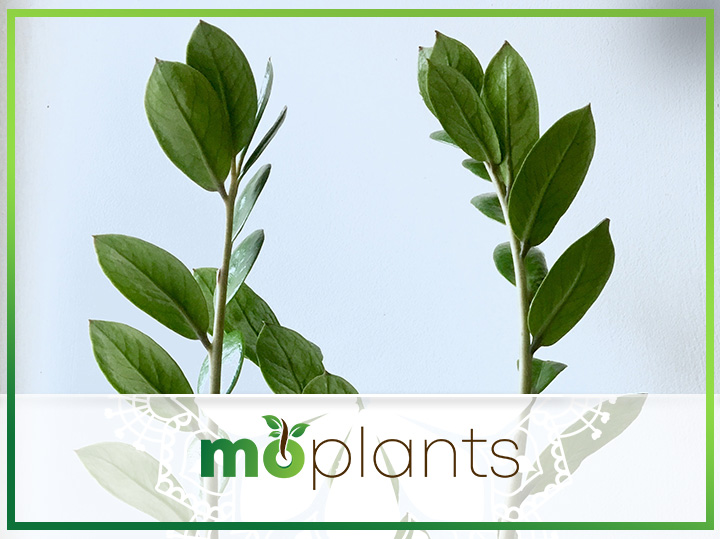People choose to grow the ZZ plant in their homes as they are some of the most resilient indoor plants one can grow. They can thrive in various conditions even when left alone and neglected – But lots of people still struggle with ZZ plant growth! If you are one of those people and are wondering, “why is my ZZ plant not growing?” this article is all about how to grow ZZ plants!
But first, what are ZZ plants?
ZZ plants are perennial tropical plants, also called the Zanzibar or the Aroid Palm. The ‘ZZ’ comes from their botanical name, Zamioculcas zamiifolia. These plants are native to eastern Africa – which makes them incredibly hardy and drought-resistant. They are an incredibly popular indoor plant choice as they are easy to care for and easy to grow. ZZ plants adapt very well to different conditions and can survive off of nothing for extended time periods.
A reason for their resiliency and hardiness is that they grow stems, called rhizomes, above and below the surface. These rhizomes are stems that grow roots and shoots that store beneficial nutrients and water for extended periods of time and help these plants survive. These plants are also known to clean and filter the air around them, improving air quality, which is another reason for their popularity among indoor growers.
The ZZ plant is very easy to care for, but that doesn’t mean these plants are also easy to grow. While the ZZ plant is famous for its survivability – survivability doesn’t equal growth! These plants are slow-growing plants, and they prefer certain conditions to grow and do more than survive. So, the answer to your question of “why is my ZZ plant not growing?” could be that it is, just very slowly. Before you go ahead and change up your ZZ plant’s whole routine, you should know how much growth to expect from these plants.
How much growth should you expect from your ZZ plant?
As we said earlier, ZZ plants are slow-growing plants. Even in the perfect conditions, their growth rate will be much slower than most houseplants. Getting ZZ plants to their full size can take several years, as they typically only grow an average of 6 stems every growing season.
The growing season of ZZ plants starts from early spring until the end of summer, and their growth stops during the winter months. ZZ plants become dormant during the winter months, which means they don’t grow at all – this could be one of the reasons why people think their ZZ plants aren’t growing.
Now, there might be a number of reasons why your ZZ plant is struggling to grow. It could be the environment, the lack of nutrients in the soil, or the plant’s living conditions. However, this article is here to help your ZZ plant thrive, and there are a lot of factors that could stunt the growth of your ZZ plant – Let’s look into them!
Why is my ZZ plant not growing? The Causes:
There can be a lot of causes behind your ZZ plant’s stunted growth. You’ll have to evaluate how and how much you water, the lighting, temperature, and, of course, the soil. Let’s get into some more detail.
Determine if it is growing season
We talked about this briefly earlier – ZZ plants are dormant during the winter season, even while being indoors and in warm and perfect conditions. If you notice the halt in growing as soon as the winter season comes around – around October and until March, you shouldn’t be worried at all. All you need to do is make sure your dormant ZZ plant isn’t getting overwatered during this time period. Wait until the soil is completely dry before you water your ZZ plant in the winter months – you can work on getting it growing once the winter season is over.
Watering
Even though ZZ plants are drought-resistant and very hardy, they hate being overwatered. Underwatering, while not as big of an issue as overwatering, will still slow down the growth of your plant, but it won’t kill them. Overwatering your ZZ plants, however, can cause root rot. Root rot is incredibly harmful to the ZZ plant and causes it to completely wither and die.
You can tell if you are overwatering or if your plant has developed root rot by a few signs. Root rot can change the color of the leaves and stems; this could be from bright green to brown, grey, or even black. Droopy leaves or stems are also a sign of root rot. Finally, if there is a moldy, foul odor or actual mold growing around the base of the plant – it could mean root rot has spread in your ZZ plant.
Inadequate Lighting
While ZZ plants are known for surviving in low light, but, as we said before, surviving is different from growing. Many people think ZZ plants can be placed in any corner of a home, and they will grow and thrive – but they need at least a few hours of bright but indirect sunlight each and every day to grow.
Temperature
As we mentioned in the intro of this article, the ZZ plant is native to eastern Africa. This means they are used to medium to high temperatures and do not thrive in low temperatures. The ideal temperature for the ZZ plant to grow and thrive is between 60°F – 75°F. Temperatures below 45°F will cause these plants to become dormant or even die.
Humidity
The ZZ plants are able to handle both dry and high-humid conditions. Though an extreme of both, whether high or low humidity, will cause your plants to grow slower. Indoor places like bathrooms, laundry rooms, and kitchens might be too high in humidity for the ZZ plant to thrive in. ZZ plants would be best somewhere in the middle, between 40%-50% humidity levels.
Soil And Fertilization
Nutrient deficiency in the potting soil could be a cause for stunted growth. Even though these plants are extremely resilient, if your ZZ plant has been in the same pot for a long time now, it might have used up all the nutrients, and the soil might not be able to sustain your plant’s growth. You will have to refresh the soil with new nutrients using fertilizers or by repotting the plant into newer, nutrient-rich soil. You should also make sure the soil isn’t too wet, and it is well-drained, so the roots of your ZZ plant aren’t too wet.
Check if your ZZ plant is rootbound
Rootbound basically means when the roots of your plant have grown into a tangled mess and filled up the pot they are placed in. This leaves no more space for new rhizomes, stems, and roots to grow, which could be the reason why your ZZ plant isn’t growing. You can see if your ZZ plant is rootbound by seeing if there are roots growing out of the drainage holes of the pot.
Pests and Diseases
Of course, the last reason why your ZZ plant isn’t growing could be pests and diseases. Check your ZZ plant for any signs of pests or diseases. If you see any signs of either, you immediately isolate it from any other plants you might have in order to stop the spread.
Infographic

Why is my ZZ plant not growing? Suggestions to get your ZZ plant growing again!
Now that you know about the possible causes behind your ZZ plants not growing, there are many ways you can get your ZZ plant growing again. Keep these suggestions in mind, and your ZZ will soon reach its full potential and size!
Let the soil dry before you water it:
As ZZ plants are drought-resistant, they can survive underwatering easily. To make them grow, though, you need to make sure you aren’t overwatering your ZZ plants. As ZZ plants store water and nutrients in their rhizomes, they only need to be watered once every few weeks. Overwatering can cause your ZZ plant’s roots to suffocate, which stops nutrients from reaching the entirety of your plant. The watering requirement does vary, especially if you have placed your plant under bright/direct light or in an area with high temperatures – then, you’ll need to water it a bit more frequently.
To check if you are watering your plants the right way, you could use a moisture meter to ascertain the soil’s moisture levels. But you don’t really need a moisture meter; you can also determine the soil’s moisture level by, first, looking at it – when it is too dry, it looks flaky and light brown. You can also use your finger and dig up the top few inches to check the moisture levels. If it is still moist under the topsoil, you should wait until it is dry before you water your ZZ plant.
Fix your lighting:
ZZ plants require bright and indirect sunlight to grow, while they can tolerate and survive in low light conditions. To encourage growth in your ZZ plant, it needs an average amount of light – not too much and not too little. Too little will stunt the growth of your ZZ plant, and too much or direct sunlight will cause your ZZ plant leaves to burn up. A good way to provide bright, indirect, and just enough light is by placing them under fluorescent lights. ZZ plants thrive under fluorescent light, which is why they are so popular among indoor plants.
Maintain human temperature and humidity levels:
You could compare a ZZ plant’s temperature and humidity preference to that of humans. Just like us, ZZ plants prefer average room temperatures of between 60° to 75°F with average humidity levels. Any temperatures below 45°F will quickly push ZZ plants towards dormancy, and they will stop growing.
This means keeping them away from rooms with excessive draughts and air conditioners and also away from heaters or extreme lighting. Direct air from air conditioners and even heaters can cause your ZZ plant to struggle to grow. Also, use a humidifier during the drier winter months to provide it with adequate moisture to keep it thriving.
Provide your ZZ plant the nutrients it needs:
ZZ plants can thrive even without fertilizers, but if your ZZ plant has stopped growing, using fertilizers could accelerate your plant’s growth. If you do decide to use or add fertilizers to your plant’s soil, make sure not to use excess fertilizers, as this could result in your ZZ plant’s growth stopping completely. You should also only use and add fertilizers during the ZZ plant growing season – early spring until the end of summer. Also, you could make use of compost to accelerate your ZZ plant’s growth.
Repot your ZZ plant
We spoke about root rot earlier – when there is no room left in the pot for your ZZ plant to grow. Your pot could also be too large, which usually causes overwatering and stunts the growth of ZZ plants. Only move your ZZ plant into a bigger pot when you see roots growing or escaping out of the drainage holes of your pot. Also, you should repot your plant right before the growing season begins and not during the winter months. Repotting will help your ZZ plant thrive as it will renew the nutrients present in the soil, and it will have the space it requires to grow.
Infographic

Conclusion
That’s all you need to know about growing your ZZ plants! Hopefully, we were able to provide you with the answers you were looking for. If you keep in mind all our suggestions, your ZZ plant will be thriving and hopefully growing in no time. Well, in ‘ZZ plant’ time – remember, ZZ plants are naturally slow-growing. Anyone can grow and care for a ZZ plant – they are some of the best plants to grow for beginners. They will grow in their own time; all you need to do is make sure you never overwater, provide it with enough indirect sunlight, and keep it free of any diseases or pests.

